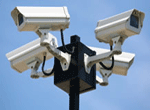
Closed Circuit Television (CCTV) cameras are the chief component of video surveillance systems. These cameras can deter and catch thieves, thus reducing the amount of money lost through theft and damages each year. CCTV cameras must be connected to a monitor which allows the company to view their store and a recorder which is used to keep a visual record of any criminal activity spotted.
Choosing A System
Different sized companies require varying setups. While a small corner shop can survive with a single CCTV camera connected to a monitor and recorder, a larger organization will need something much more complicated. Complex systems involve multiple cameras, hidden monitors and split screen activity which enables a security guard to view several cameras at once. A high frame rate is necessary in order to receive clear images but the problem with this is the large amount of space high frame rate videos take up on a hard drive. A company must decide whether they want video surveillance systems that deter or catch criminals. Obvious cameras deter, hidden cameras catch.
When it comes to purchasing video surveillance systems, there are a number of things to consider. Besides the type of CCTV you need, there is also the matter of picking a monitor, a recorder and additional items like lenses. The Charged Coupled Device (CCD) is the main technology used in cameras. The purpose of a CCD is to convert picture images into electronic impulses which results in good quality pictures at a reasonable price. Most cameras formats range between one quarter of an inch and an inch. Quarter inch cameras are commonly used in CCTV cameras. The main advantage of larger formats is their ability to capture more light in dark areas so a one inch camera may be the best choice for outdoor surveillance.
Color CCTV Cameras
Black and white CCTV cameras are virtually a thing of the past. Color cameras are more advantageous because they obviously provide a clearer picture and make suspects easier to identify. Black and white cameras are only useful for surveillance in low light areas with modern cameras able to switch between color and black and white. Horizontal TV lines (TVL) measure resolution with 500 TVL or more deemed to be high resolution. A signal to noise ratio of 60db (Decibels) gives off perfect images with no static. A camera’s lens is important when it comes to the width of an image as this controls the amount of light it allows in. Always buy lenses that match a camera’s format. This means a quarter inch CCTV camera needs a quarter inch lens.
Monitors
Monitors used in video surveillance systems should not be televisions. This is because TV’s are designed to be on for a few hours a day only whereas a surveillance system must be on all day, everyday. Flat screen LCD computer monitors are an acceptable substitute because they are small, create less heat than normal monitors and produce a superb picture. The resolution of a monitor must be the same as that of the camera or else the images will not be clear. A 9 inch monitor should only be used for single cameras. If you are planning to combine several cameras onto one screen, the monitor must be 15 inches at the very least.
Recorders
Video surveillance systems without recording are a waste of money. Without video evidence, there is no way to prosecute a criminal. VCR’s have been used for recording for generations but have now been replaced by Digital Video Recorders (DVRs). DVRs prevent you from having to wade through hours of tape. This form of recording is the main difference between low and high-end video surveillance systems. Low-end systems still use VCR footage to record. Although it does its job, it can take a very long time to find a recorded incident due to the constant fast forwarding and rewinding. With a DVR, you can immediately go to a specific time or date.
Another problem with low-end VCR systems is the fact that the tape quality diminishes every time you use it. As DVR footage is stored on a hard drive, the picture quality remains the same. VCRs can only record or play while DVRs enable you to view footage while still recording. A DVR recording can be set to one frame a second to start the recording process but immediately move to a high quality 30 frame per second speed to clearly capture events.
Value For Money
Low-end video surveillance systems are cost-effective security solutions for small companies with CCTV cameras available for $120 apiece and lenses available for $100 each. Low-end systems will be able to monitor a certain number of rooms but will not be capable of picking up blind spots. High-end system cameras will cost at least $250 each with automatic zoom lenses retailing at around $800. Yet these systems will be able to pick up on all suspicious activities and have the ability to place a number of cameras on the same monitor. This means the security guard will not miss a single incident if he/she is observant enough.
You need to avoid the temptation of buying low quality video surveillance systems, especially if your company generates a large profit. Although the initial expense may seem high, the level of security it provides will ensure that it is a worthy investment.

